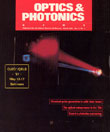
March 1991 Issue
Feature Articles
Auto-random-dot stereograms
We perceive depth in our normal vision because our brain stereoscopically combines the two slightly different views from our horizontally separated eyes. Although there are other (monocular) depth cues such as shading and perspective, humans are particularly receptive to this binocular disparity. In fact, picture pairs (or stereograms) can induce stereopsis when they are contrived binocular disparity. Typical stereograms, such as 3-D movies, contain several monocular depth cues because each component image forms a realistic, two-dimensional scene when viewed separately. Conversely, random-dot stereograms combine two seemingly random black-and-white patterns of dots, which, when viewed stereoscopically, produce a three-dimensional figure solely on the basis of binocular disparity.1 Because of the lack of several interacting depth cues, it may take several minutes for the observer to recognize depth from the random-dot patterns, while it only takes milliseconds to perceive ordinary stereograms.
by Lenore PuglieseNew Technologies For Ultrashort Pulse Generation In Solid State Lasers
Recent advances in ultrashort pulse generation techniques suggest that a new ultrashort pulse laser technology can be developed for solid state laser sources. These new laser systems will achieve superior performance and have reduced cost and complexity compared to traditional dye laser technology. The development of solid state ultrashort pulse sources will pave the way for a wide range of research and engineering applications of high speed ultrashort pulse technology.
by James G. Fujimoto

![A multiplexed image of a human tonsil acquired. [NIAID] using the iterative bleaching extends multiplexity (IBEX) method.](https://opnmedia.blob.core.windows.net/$web/opn/media/images/articles/2024/0424/departments/202404-cover-web.jpg?ext=.jpg)
